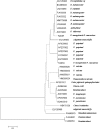Detection of Wolbachia pipientis, including a new strain containing the wsp gene, in two sister species of Paraphlebotomus sandflies, potential vectors of zoonotic cutaneous leishmaniasis
- PMID: 23828002
- PMCID: PMC3970627
- DOI: 10.1590/S0074-0276108042013004
Detection of Wolbachia pipientis, including a new strain containing the wsp gene, in two sister species of Paraphlebotomus sandflies, potential vectors of zoonotic cutaneous leishmaniasis
Abstract
Individual, naturally occurring Phlebotomus mongolensis and Phlebotomus caucasicus from Iran were screened for infections with the maternally inherited intracellular Rickettsia-like bacterium Wolbachia pipientis via targeting a major surface protein gene (wsp). The main objective of this study was to determine if W. pipientis could be detected in these species. The sandflies were screened using polymerase chain reaction to amplify a fragment of the Wolbachia surface protein gene. The obtained sequences were edited and aligned with database sequences to identify W. pipientis haplotypes. Two strains of Wolbachia were found. Strain Turk 54 (accession EU780683) is widespread and has previously been reported in Phlebotomus papatasi and other insects. Strain Turk 07 (accession KC576916) is a novel strain, found for first time in the two sister species. A-group strains of W. pipientis occur throughout much of the habitat of these sandflies. It is possible that Wolbachia is transferred via horizontal transmission. Horizontal transfer could shed light on sandfly control because Wolbachia is believed to drive a deleterious gene into sandflies that reduces their natural population density. With regard to our findings in this study, we can conclude that one species of sandfly can be infected with different Wolbachia strains and that different species of sandflies can be infected with a common strain.
Figures



References
-
- Beard CB, O'Neill SL, Tesh RB, Richards FF, Aksoy S. Modification of arthropod vector competence via symbiotic bacteria. Parasitol Today. 1993;9:179–183. - PubMed
Publication types
MeSH terms
Associated data
- Actions
LinkOut - more resources
Full Text Sources
Other Literature Sources

